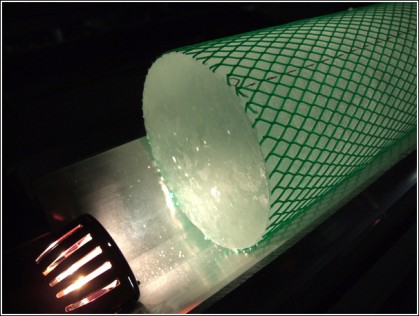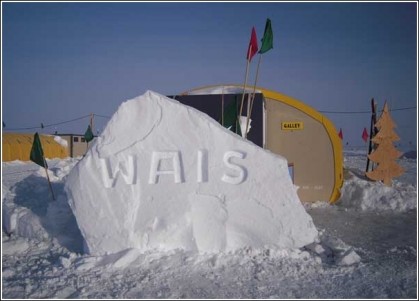18 December 2009
WAIS-The Most Remote Science Station On Earth (and perhaps the most critical)
Posted by Dan Satterfield
It’s 1025 miles from the U.S. science base at McMurdo and about 725 miles from the Amundsen Scott Station at the South Pole. The South Pole station is a Hilton compared to the WAIS site. Yet this collection of buildings on top of a two mile thick glacier of ice are making the most important scientific observations in the world. They are drilling all the way to the rocks of Antarctica.

Ice core from the WAIS drill site in West Antarctica. Tiny bubbles of air in the ice will tell researchers the carbon dioxide levels in the atmosphere the year the snow fell.
The goal is to produce a two mile long core of ice. That ice will tell researchers what the planet’s temperature and carbon dioxide levels have been for the past 40,000 years! Data by decades may reach back over 100,000 years!
The weather at WAIS is bad even by Antarctic standards. A typical summer day means temps around -20. A sudden wind storm of 60 mph is common (Kendrick Taylor the principal investigator at WAIS emailed to tell me that at 40 mph anything beyond 50 feet is invisible!). It may not be the middle of nowhere, but they have a deck and for a quarter you can see it from there!
In two weeks I am to have the very rare and very special opportunity to go there.
I think I’m looking forward to visiting WAIS even more than standing at the bottom of the world at the South Pole. I get to do both.
To visit WAIS I must complete a snow survival school at McMurdo. Sleeping at WAIS will be in tents I hear. Yea, at 20 below.
Why is the National Science Foundation spending so much money to drill two miles through the ice at the bottom of the world??
It’s simply this- we need to know what the climate has done in the past to better predict it in the future. The ice cores that have already been done in Greenland and shorter cores in Antarctica rewrote text books on climate.
I was told in school (30 years ago) that climate changed very slowly. Almost undetectably in a human life span. That’s what we thought.
WRONG.
We now know that our climate has been unusually stable for the past 10,000 years. We also know it can change in a decade to a much different setting on the thermostat.
Mankind is currently conducting the most dangerous experiment ever devised by doubling the carbon dioxide levels of the atmosphere. At the present rate, we will reach the doubling point in about 20 or 30 years. It’s vital that we know just what the results of doing so will be.
The current theories are rather scary.
In all the political noise about climate change, there is really only one basic scientific question.
If we double the CO2 levels, what will happen to our climate and what will be the consequences.
In part two I will tell you what the experts are thinking the answer is and why the ice cores are so important.
Dan




 Dan Satterfield has worked as an on air meteorologist for 32 years in Oklahoma, Florida and Alabama. Forecasting weather is Dan's job, but all of Earth Science is his passion. This journal is where Dan writes about things he has too little time for on air. Dan blogs about peer-reviewed Earth science for Junior High level audiences and up.
Dan Satterfield has worked as an on air meteorologist for 32 years in Oklahoma, Florida and Alabama. Forecasting weather is Dan's job, but all of Earth Science is his passion. This journal is where Dan writes about things he has too little time for on air. Dan blogs about peer-reviewed Earth science for Junior High level audiences and up.